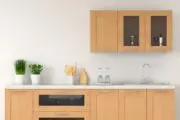Tell me if this familiar: You bring a new plant home from the nursery, with hopeful visions of your future together. You think, “This time, things will be different.” You find the perfect spot for it and even give your plant a name. A few weeks pass and ‘Diana Moss’ seems to be doing well — you’ve remembered to water her and the leaves are full, with a bright green hue. But then you get busy at work, you go away for the weekend, life gets in the way— and when you come home, your once-thriving green friend has lost all of its lustre. Leaves start dropping — or worse — turning brown. Another one bites the dust.
For well-intentioned plant parents, figuring out what your indoor garden needs can feel more cryptic than deciphering a text message from a flaky crush. But the good news: Plants are actually very easy to keep alive — so long as you keep these four simple principles in mind.

Here’s the thing: Indoor plants aren’t designed to stay alive forever
I got my first plant when I was 19. Ten years later, some of my very first plants are still alive. But more have died than I’d care to count. I teach a workshop called How Not To Kill Your Houseplants and I always start the class by assuring participants that everybody kills plants. At some point, every professional botanist, horticulturist, garden center employee, plant amateur and serious collector has committed murder.
The truth is, it’s unnatural to keep a plant alive in a small pot for years and years. In nature, plants have an entire ecological system to pull from — they can grab endless moisture and nutrients from the earth, grow in areas where the lighting conditions are ideal for them, and they don’t need a human to remember to water them. Mother Nature takes care of that.
When plants are growing up in a greenhouse, they’re hopped up on the best conditions which encourage accelerated growth — unobstructed light from all angles, appropriate water and fertilizers. Because the lighting conditions are so ideal, the plants are photosynthesizing quickly. For this reason, they require constant waterings — which they get in droves. After the plant travels from the greenhouse to a plant nursery, hardware store or IKEA near you, they’re suddenly subjected to unsavoury (aka dark) conditions. By the time you bring the plant home, it’s already been in shock for weeks and might show signs of distress before you’ve even had a chance to demonstrate your plant care chops.
But with a basic understanding of light, water and soil, you can get your plants back on track and keep them thriving indoors for a long time.

1. Plants die because of neglect
Admit it: Sometimes you forget to water your plants. We all do. Here’s the thing, most plants need water once a week. Some species are more forgiving if you skip a watering, while others will punish you immediately.
There are many exceptions to this rule. If you have a six-foot cactus, for example, you can potentially go months without watering it. Snake plants and zanzibar gems require water every two weeks or so. But as a general rule, most plants want to be checked in on at least once a week. Being a responsible plant parents doesn’t mean your indoor garden should take up all of your free time. If you only have a handful of plants in ideal lighting conditions, they shouldn’t need more than 15-minutes of love a week.
Sometimes, plant parents go in the other direction and kill their plants because they love them too much. Over-mothering is by far the most tragic cause of death. The truth is, houseplants are easy pets. If you find yourself watering your plants every day, you’re overdoing it.

2. Plants die because of improper watering techniques
Overwatering: Overwatering is one of the leading causes of death for houseplants. Since lighting conditions are never as good in a house as they are in a greenhouse, the plant will photosynthesize slowly. When you water constantly, the plant doesn’t have the chance to absorb water through the leaves. This can easily lead to root rot, mold, yellowing leaves, bacteria or bugs.
Underwatering: On the other hand, it’s really easy to underwater your plants — either by skipping a watering or not giving it enough when you do. To give you a sense, imagine filling your plant’s pot with one third of water. That’s a safe estimate for how much it can handle (but you should always research your plant to make sure). For example, I have five-foot fiddle leaf fig tree that I water every seven to ten days. When I do, I fill a wine bottle with water and pour the entire thing in the soil — sometimes more, if it’s been particularly bright or dry out.
Putting the plant in a pot without a drainage hole: In the greenhouse, plants come in plastic growers pots with multiple drainage holes at the bottom. Many people think these pots are bad for their plants and place them into decorative pots (without a drainage hole at the bottom) as soon as they get home. When pots don’t have drainage, the water has nowhere to escape after a watering. This potting method reduces root oxygenation and therefore, overall root health. Unless you’re a pro, always have a drainage hole in your pot. I personally keep all of my plants in the plastic growers pots they came in and then place those inside decorative pots.
Blindly following watering instructions: I realize I just told you most plants needs water every week or so. Don’t listen to me, or anyone else, until you’ve checked the soil. When you read care instructions, it’s assuming you have the perfect lighting conditions. But how much light your plants gets is the major determinant of how quickly the moisture in the soil will absorb. You must check soil moisture before giving it a meal. If the top inch of soil still feels moist since your last watering, it’s likely not ready for more, and may have gotten overwatered. No plant likes to be soaking wet for an extended period of time. Some like to be moist at all times, dry out completely or dry out halfway between waterings. The best rule of thumb? Put your finger in the soil to assess the moisture levels.
Using freezing cold water: Plants like room temperature water. If you use freezing cold water out of the tap, it can shock the roots. A good trick: Fill your watering cans the night before you water.
Failing to evenly saturate the soil: To keep the air flowing in the soil and around the roots, and to cleanse any chlorine or bacteria build-ups, it’s important to water the soil evenly. This can be done by watering the plant from the top, slowly pouring the water over every square inch. Or, if your pot has a drainage hole (which it should), you can fill a larger bowl with water and place the pot inside it. The plant will suck up the water from the bottom through the holes in the pot. If there is water left in the vessel after an hour or so, be sure to dump out any of the remains so that the roots don’t sit in water for an extended length of time.

3. Plants die because they don’t get enough light
Unless you have a low light plant (I wrote a detailed list of my favorites), most plants require direct or bright-indirect light.
Not sure how to read your light source? I wrote an in-depth guide but here’s the gist: Cacti and succulents are desert plants and love direct light. This means there is nothing obscuring the light source, it’s likely in a south- or west-facing window and they get full sun (the sun rays fall directly on the plants for at least six hours a day). Tropical plants usually like bright, indirect light. This means the plants are in a bright room but the rays of light are filtered. For example, when a tropical plant is growing in a greenhouse, there is a sheer fabric that lines the roof of the greenhouse to protect them.
If you have a particularly dark room and the plant requires bright, indirect light — it will never thrive in that space. While plants are certainly beautiful design objects, your interior sensibilities should not determine plant placement. Maybe you really love the way the succulent looks on your end table, but it actually wants to be on the window sill. There is no room for compromise here — unless you want to replace your plants every few months.

4. Plants die because you haven’t researched the species’ requirements
Every plant needs water, light, air and soil (with the exception of airplants and a few other varieties) to survive. How much you give each plant will vary from species-to-species. While this article is designed to give you a fundamental understanding so you can troubleshoot, it’s important to do your own research to figure out what your plant likes. Does it want low light or direct light? Does it prefer the soil to stay evenly moist or dry out entirely between waterings? My tip is to get the name of the plant (pothos, for example) and simply type ‘pothos plant care’ or ‘pothos houseplant 411’ into Google. With these tips and the help of your favorite search engine, Diana Moss will be thriving in no time.






